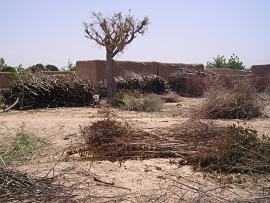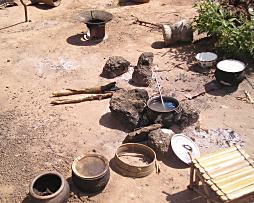
Opportunity Ripe for Solar Cooking in Mali
During my recent trip to Mali, I awoke at 4:30 AM one morning. The roosters were crowing, the sun was announcing its arrival and the call to prayer cut through the stillness. The women had already started their wood fires and were preparing breakfast for the family, usually a porridge made of rice or millet. In some families, this task falls to the young girls, especially if their mother has already left the village to forage for cooking fuel.
 In Mali, as in most African countries, it is the women who shoulder the burden of foraging. It is hard labor requiring hours away from home and family. Even when they can collect enough to sell, the compensation is meager. A donkey cartload of wood brings less than $3.
In Mali, as in most African countries, it is the women who shoulder the burden of foraging. It is hard labor requiring hours away from home and family. Even when they can collect enough to sell, the compensation is meager. A donkey cartload of wood brings less than $3.
Often, family supervision is left to an elderly female relative, or to neighbors. It is the women who go to market, process grains, rear the children, tend the garden — in short, perform all domestic chores.
Each cartload of wood lasts a week in the average family, bringing the cost of fuel wood to at least $11 per month. In some cases, that is a quarter of a family’s income. Most wood is collected during the dry season and stockpiled unprotected from the elements. During the rainy season, it becomes more expensive as supplies dwindle. It also smokes more if burned when wet, increasing the risk of respiratory disease.
The rising cost of cooking fuel and lack of available alternatives are undoubtedly having adverse effects on economic development. It is also causing cultural change. For example, the gathering of the family three times a day for meals has been a strong tradition. This is breaking down because of the high cost of cooking fuel. In urban areas where costs are highest, some families are gathering for only one meal and will search for food elsewhere at other times in order to lessen the family burden.
In the Saharan towns of Timbuktu and Kidal, wood supplies have vanished altogether. In rare cases when some wood turns up in the Gao marketplace, it is bought within minutes of its arrival. Most people are reduced to cooking with dried camel dung. It is in these areas of northern Mali that the need for an alternative, clean cooking fuel is most urgent.
Mrs. Aissata Sissoko, an entrepreneur in Bamako, recalls her most recent visit to Gao: “When I woke up in the morning, my hostess was upset. She explained that she was unable to prepare a hot breakfast for me. She told me that she had been searching late into the night for wood, and had continued her search early in the morning. Unfortunately, she found nothing.”
Mrs. Sissoko lamented, “Malians are tired, we’re all very tired. Everywhere I go, everyone is talking about the immediate need for an alternative fuel. We live in this vicious cycle of working tirelessly to earn a humble salary, then spending it all to buy food and fuel for cooking. Cooking fuel is so expensive, but we have no choice. It is an incredible burden to endure.”
Bottled gas, or LPG, is not a viable alternative cooking fuel. In the first place, it is unavailable to the 70% of the population who live in the countryside. Furthermore, even the subsidized cost of LPG is much higher than traditional fuels. Every family, no matter the socio-economic level, is adversely affected.
According to the United Nations, eighty-eight percent of the energy used in Mali comes from wood, charcoal or animal waste. Six million tons of wood are consumed in Mali each year, an estimated twenty times more wood than is replaced. The Government of Mali reports that each year, the desert advances six kilometers further into habitable territory. “The situation has reached a critical point,” says Mr. Gnibouwa Diassana, who works in the Agroforestry Department of World Vision Mali. “We have to act now to introduce an alternative, or face catastrophe in the near future.”
In the capital city of Bamako, the fuel of choice is charcoal. It’s the cheapest, it’s easy to transport and it smokes less than wood. Few know how inefficient producing it really is; when wood is burned to make charcoal, over half of the energy is lost. It takes 7 kilograms of wood to make 1 kilogram of charcoal. The average family will go through a 35kg bag in about a week, bringing the monthly cost to at least $11. Depending on the season and the size of the family, this figure can be as high as $33 monthly. By contrast, the same family will spend up to $8.25 for millet each month and up to $13 for good quality rice.
Because wood is consumed at an unsustainable rate, providers must go ever further into the countryside to meet demand. They sometimes travel 40 or 50kms from town with a donkey cart to collect a load of wood.
 One potential resource found in abundance in Mali is the sun. Temperatures during the day, any time of year, can climb to 100 degrees Fahrenheit or more. The sun is relentless. A large tree stands in the courtyard of every dwelling no matter how modest. Its shade is a family’s only escape from the oppressive heat. Periodically, as its shadow moves, everyone under it will gather up their mat in unison and move with it. And they are careful to avoid any splashes of sunlight that penetrate the leaves.
One potential resource found in abundance in Mali is the sun. Temperatures during the day, any time of year, can climb to 100 degrees Fahrenheit or more. The sun is relentless. A large tree stands in the courtyard of every dwelling no matter how modest. Its shade is a family’s only escape from the oppressive heat. Periodically, as its shadow moves, everyone under it will gather up their mat in unison and move with it. And they are careful to avoid any splashes of sunlight that penetrate the leaves.
The move to harness this energy has finally begun. In some of these rural areas which may never be attached to an electrical grid, the sun is powering photovoltaic panels which deliver electricity for light and a TV or a radio. Solar panels are also being installed at some schoolhouses and medical centers.
So, too, will solar ovens improve the lot of many thousands of Malians. They will lessen the burden of collecting firewood and decrease the risk of respiratory illness and of burn injury. And the fuel is free! Mr. Diassana affirms that, “making use of the sun’s energy is a simple solution to a complex problem. We have a free source of energy here in Mali and can easily take advantage of it by using solar ovens and solar dryers.”
There are many types of solar cookers meeting many different needs. One with wide application is a panel oven called the HotPot, recently produced in Mexico. It was developed through 9 years of research and extensive field testing to combine efficiency and durability with low cost.
A HotPot prototype was sent to Mali in 2003 for testing by a local entrepreneur. It generated a lot of interest on two counts. Malians are not only tired of having to depend on their traditional fuels, they are increasingly concerned about environmental degradation. Many see the HotPot as an attractive, efficient alternative.
In June of 2004, the HotPot was introduced to several development projects in Mali. Reactions were again very positive. People loved its design and user friendliness. Those who attended demonstrations found the food savory and well cooked. They were also surprised at what little labor was required to cook. They quickly realized this technology could liberate women. It would allow much more time for child-rearing, literacy classes or an income generating activity.
The HotPot complements the Government of Mali initiative to: “increase the access of isolated, low income populations to basic energy services to help achieve economic growth and poverty reduction targets, including those linked with the Millennium Development Goals.” To this end, Mali has suspended import duties on solar technology products, including solar ovens.
The HotPot has great potential to bring significant and sustainable improvement in the quality of life to a country that appears eager to embrace it. Arrangements for its commercial introduction are well under way.
The author is a program associate for Solar Household Energy, Inc.



